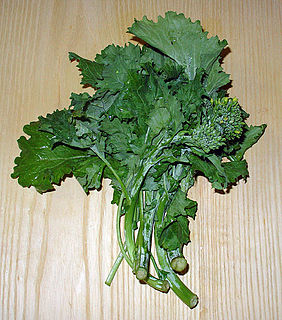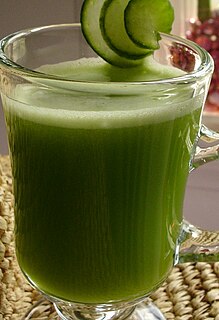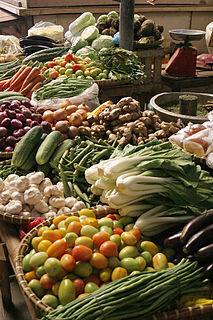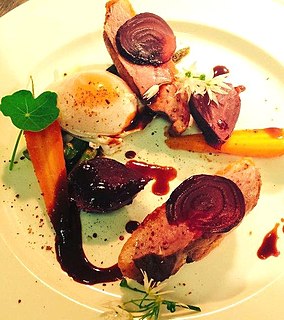
In botany, a fruit is the seed-bearing structure in flowering plants that is formed from the ovary after flowering.

Vegetarian cuisine is based on food that meets vegetarian standards by not including meat and animal tissue products. Lacto-ovo vegetarianism includes eggs and dairy products. Lacto vegetarianism includes dairy products but not eggs, and ovo vegetarianism encompasses eggs but not dairy products. The strictest form of vegetarianism is veganism, which excludes all animal products, including dairy, honey, and some refined sugars if filtered and whitened with bone char. There are also partial vegetarians, such as pescetarians who eat fish but avoid other types of meat.

Cabbage, comprising several cultivars of Brassica oleracea, is a leafy green, red (purple), or white biennial plant grown as an annual vegetable crop for its dense-leaved heads. It is descended from the wild cabbage, and belongs to the "cole crops" or brassicas, meaning it is closely related to broccoli and cauliflower ; Brussels sprouts ; and Savoy cabbage.

Brassica is a genus of plants in the cabbage and mustard family (Brassicaceae). The members of the genus are informally known as cruciferous vegetables, cabbages, or mustard plants. Crops from this genus are sometimes called cole crops—derived from the Latin caulis, denoting the stem or stalk of a plant.

Cauliflower is one of several vegetables in the species Brassica oleracea in the genus Brassica, which is in the Brassicaceae family. It is an annual plant that reproduces by seed. Typically, only the head is eaten – the edible white flesh sometimes called "curd". The cauliflower head is composed of a white inflorescence meristem. Cauliflower heads resemble those in broccoli, which differs in having flower buds as the edible portion. Brassica oleracea also includes broccoli, Brussels sprouts, cabbage, collard greens, and kale, collectively called "cole" crops, though they are of different cultivar groups.

A wedding cake is the traditional cake served at wedding receptions following dinner. In some parts of England, the wedding cake is served at a wedding breakfast; the 'wedding breakfast' does not mean the meal will be held in the morning, but at a time following the ceremony on the same day. In modern Western culture, the cake is usually on display and served to guests at the reception. Traditionally, wedding cakes were made to bring good luck to all guests and the couple. Nowadays, however, they are more of a centerpiece to the wedding and are not always even served to the guests. Some cakes are built with only a single edible tier for the bride and groom to share, but this is rare since the cost difference between fake and real tiers is minimal.

Kale, or leaf cabbage, belongs to a group of cabbage cultivars grown for their edible leaves, although some are used as ornamentals. Kale plants have green or purple leaves, and the central leaves do not form a head. Kales are considered to be closer to wild cabbage than most of the many domesticated forms of Brassica oleracea.

Rapini or broccoli rabe is a green cruciferous vegetable, with the leaves, buds, and stems all being edible; the buds somewhat resemble broccoli, but do not form a large head. Rapini is known for its slightly bitter taste, and is particularly associated with Mediterranean cuisine.

Vegetable juice is a juice drink made primarily of blended vegetables and also available in the form of powders. Vegetable juice is often mixed with fruits such as apples or grapes to improve flavor. It is often touted as a low-sugar alternative to fruit juice, although some commercial brands of vegetable juices use fruit juices as sweeteners, and may contain large amounts of sodium.

Broccolini or baby broccoli is a green vegetable similar to broccoli but with smaller florets and longer, thin stalks. It is a hybrid of broccoli and gai lan, both cultivar groups of Brassica oleracea. The name broccolini is a registered trademark of Mann Packing.

Leaf vegetables, also called leafy greens, salad greens, pot herbs, vegetable greens, or simply greens, are plant leaves eaten as a vegetable, sometimes accompanied by tender petioles and shoots. Although they come from a very wide variety of plants, most share a great deal with other leaf vegetables in nutrition and cooking methods.

A flower bouquet is a collection of flowers in a creative arrangement. Flower bouquets can be arranged for the decor of homes or public buildings, or may be handheld. Handheld bouquets are classified by several different popular shapes and styles, including nosegay, crescent, and cascading bouquets. Flower bouquets are often given for special occasions such as birthdays, anniversaries or funerals. They are also used extensively in weddings as well as Olympics Medal Ceremonies. Bouquets arranged in vases or planters for home decor can be arranged in either traditional or modern styles. Symbolism may be attached to the types of flowers used, according to the culture.

Edible flowers are flowers that can be consumed safely. Flowers may be eaten as vegetables as a main part of a meal, or may be used as herbs. Flowers are part of many regional cuisines, including Asian, European, and Middle Eastern cuisines.

5 A Day is any of various national campaigns in developed countries such as the United States, the United Kingdom, France, and Germany, to encourage the consumption of at least five portions of fruit and vegetables each day, following a recommendation by the World Health Organization that individuals consume "a minimum of 400g of fruit and vegetables per day ." A meta-analysis of the many studies of this issue was published in 2017 and found that consumption of double the minimum recommendation – 800g or ten a day – provided an increased protection against all forms of mortality. In some places, people are being encouraged to aim for not just five portions a day, but seven.

Vegetables are parts of plants that are consumed by humans or other animals as food. The original meaning is still commonly used and is applied to plants collectively to refer to all edible plant matter, including the flowers, fruits, stems, leaves, roots, and seeds. An alternate definition of the term is applied somewhat arbitrarily, often by culinary and cultural tradition. It may exclude foods derived from some plants that are fruits, flowers, nuts, and cereal grains, but include savoury fruits such as tomatoes and courgettes, flowers such as broccoli, and seeds such as pulses.

A smoothie or smoothy is a drink made by puréeing fruit and vegetables in a blender. A smoothie often has a liquid base such as fruit juice, dairy products, such as milk, yogurt, ice cream or cottage cheese. Other ingredients are often added, including non-dairy milk, crushed ice, sweeteners, vinegar, whey powder, chocolate or nutritional supplements.

A gift basket or fruit basket is typically a gift delivered to the recipient at their home or workplace. A variety of gift baskets exist: some contain fruit; while others might contain dry or canned foods such as tea, crackers and jam; or the basket might include a combination of fruit and dried good items. Gourmet gift baskets typically include exotic fruit, and often include quality cheese and wine, as well as other nonfood items. Gift baskets are often sent for special occasions—such as holidays—or as a thank-you or congratulations gift. In certain occasions, it is given as a sympathy gift or a condolence gift during funerals. In some countries in Asia, people use fruit basket as a decoration. They either eat it after the funeral service where the casket is laid in the cemetery or they leave the fruit baskets at their graves to let the dead rest in peace.

Hangwa is a general term for traditional Korean confections. With tteok, hangwa forms the sweet food category in Korean cuisine. Common ingredients of hangwa include grain flour, fruits and roots, sweet ingredients such as honey and yeot, and spices such as cinnamon and ginger.

Food presentation is the art of modifying, processing, arranging, or decorating food to enhance its aesthetic appeal.

Juice is a drink made from the extraction or pressing of the natural liquid contained in fruit and vegetables. It can also refer to liquids that are flavored with concentrate or other biological food sources, such as meat or seafood, such as clam juice. Juice is commonly consumed as a beverage or used as an ingredient or flavoring in foods or other beverages, as for smoothies. Juice emerged as a popular beverage choice after the development of pasteurization methods enabled its preservation without using fermentation. The largest fruit juice consumers are New Zealand and Colombia. Fruit juice consumption on average increases with country income level.




















